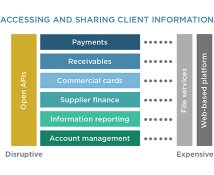How corporates are connecting with banks continues to evolve. Open application program interfaces (APIs) are an excellent example of how technology, banking and even the regulatory environment are converging, changing the way banks operate in the future. On the positive side, new capabilities mean new opportunities for service and higher customer satisfaction—both of which drive growth. Yet offsetting the positive is the fact that transitions take time and payoffs are not immediate. Important, too, is that they often introduce new competitive dynamics for all to contend with. When we think of disruptive technologies in banking, retail examples come to mind first:
- ATMs replacing tellers
- Mobile applications instead of branch visits
- Mobile payments gaining traction at the expense of credit cards
In these examples, retail banks have been rewarded with new and deeper customer relationships. In the corporate and commercial worlds, fintech has been met with more measured enthusiasm, due to the significant impact on how banks operate and banks’ fear of losing ground to new competitors. However, “waiting in the wings” has consequences, the greatest of which is disintermediation.
Banking’s future is digital. The only questions are at what pace and who will participate or be left behind.

